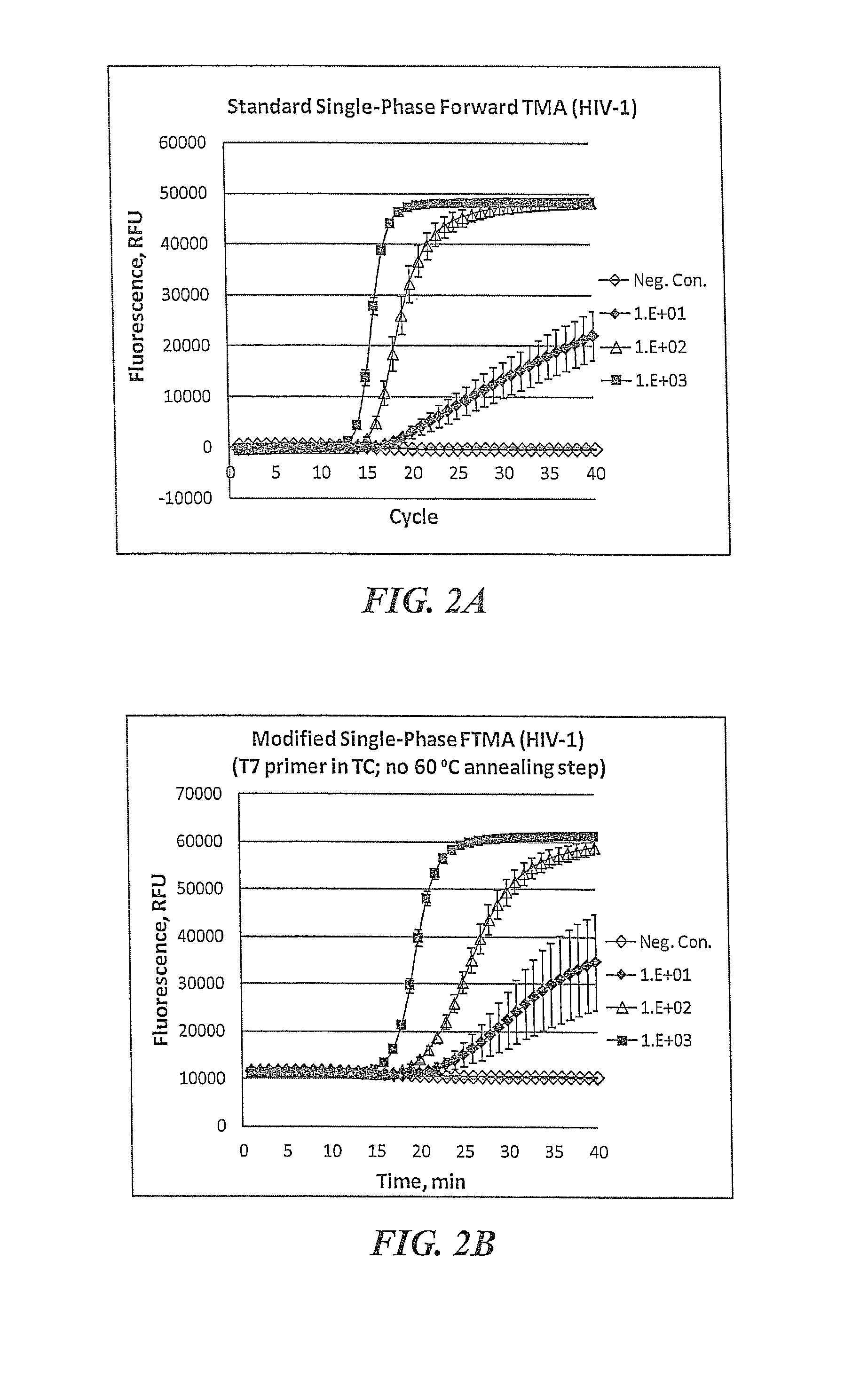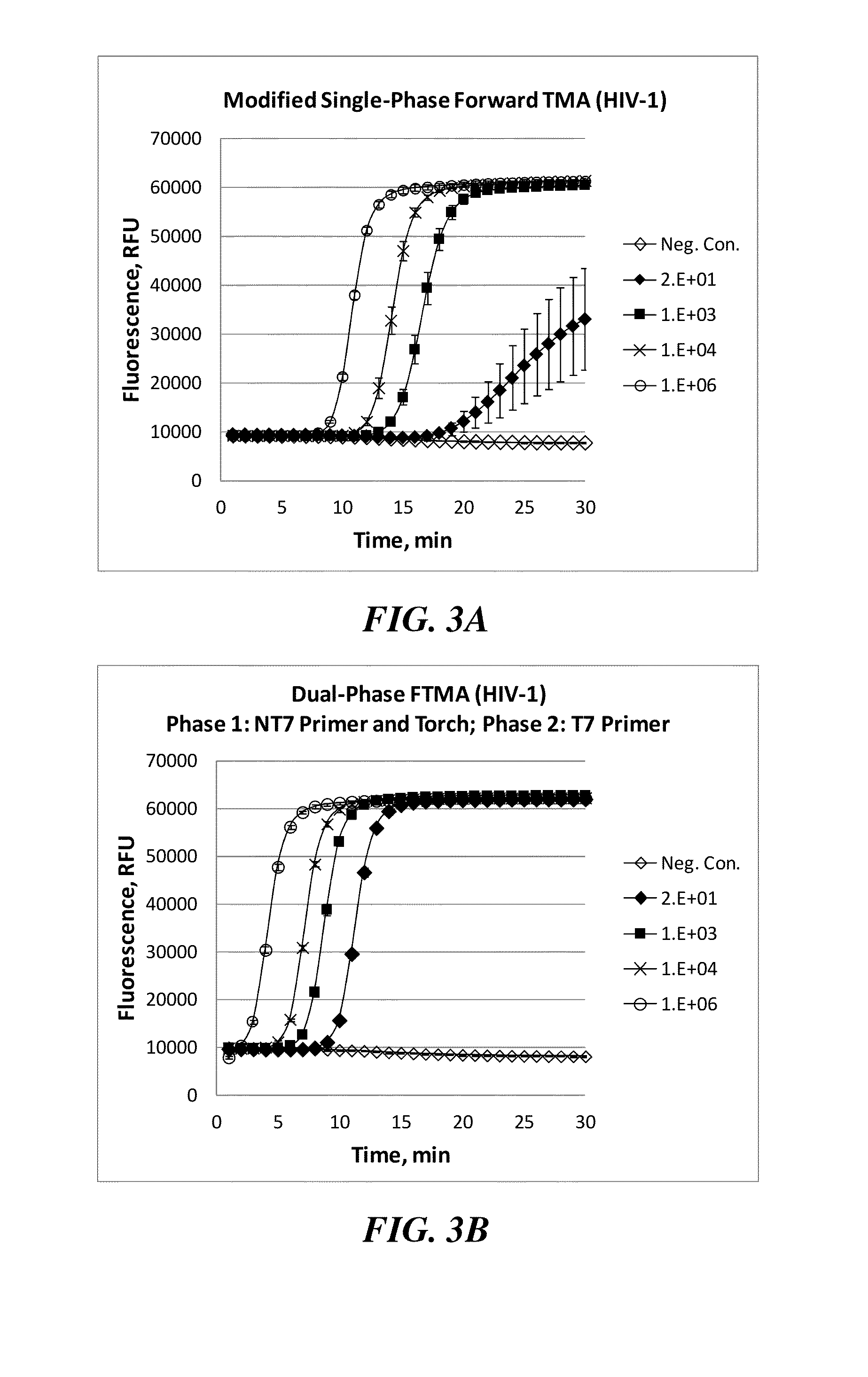Multiphase nucleic acid amplification
a nucleic acid and multi-phase technology, applied in the field of molecular biology, can solve the problems of degrading the overall performance of the desired amplification reaction, initiating unusable side reactions, etc., and achieve the effect of reducing non-specific amplification
- Summary
- Abstract
- Description
- Claims
- Application Information
AI Technical Summary
Benefits of technology
Problems solved by technology
Method used
Image
Examples
example 1
Standard Single-Phase Amplification Protocol
[0098]An exemplary protocol for standard single-phase TMA reactions that detect results in real time follows. The assay includes purification of target nucleic acids before amplification, amplification, and detection of the amplified products during amplification.
[0099]Target capture is performed substantially as previously described in detail (U.S. Pat. Nos. 6,110,678, 6,280,952 and 6,534,273). Briefly, samples are prepared to contain known amounts of target RNA (in vitro transcripts (“IVT”) present at a predetermined copy level per sample in a total volume of 400 ml of a 1:1 (v:v) mixture of water and sample transport medium). Each sample is mixed with 100 ml of TCR that typically contains 5 pmol of target capture oligonucleotide (TCO) specific for the analyte nucleic acid to be captured (i.e., 3′ target-specific binding region) and a 5′ tail region (e.g., dT3A30 sequence) for binding to the immobilized probe (e.g., poly-T oligonucleotid...
example 2
Evaluation of Dual-Phase HIV-1 Amplification in Forward TMA Format
[0101]In this example, dual-phase forward TMA was evaluated using a human immunodeficiency virus 1 (HIV-1), subtype B target template containing the pol region.
[0102]In the dual-phase amplification approach used here, which is briefly summarized in FIG. 1, a T7 primer was hybridized to the target HIV-1 sequence during target capture, followed by removal of excess T7 primer. The amplification process was divided into two distinct phases. During the first phase, a non-T7 primer was introduced along with all of the requisite amplification, detection and enzyme reagents, with the exception of additional T7 primer. In the presence of reverse transcriptase, the T7 primer hybridized to the target was extended, creating a cDNA copy, and the target RNA template was degraded by the reverse transcriptase's RNase H activity. The non-T7 primer subsequently hybridized to the cDNA and was then extended, filling in the promoter regio...
example 3
Optimization of Dual-Phase HIV-1 Amplification Parameters
[0104]The first priority in the optimization process was to slow the emergence times and separate the individual target input levels to allow accurate and precise quantification, as well as reduce any putative interference with the non-T7 primer. This was accomplished by titrating down the T7 primer concentration in the second phase (amount used in the dual-phase reaction depicted in FIG. 3B was 10 pmol / rxn). The assay was shown to retain 10 copies / rxn sensitivity and high precision with the lowest amount of T7 provider tested (1.0 pmol / rxn; FIGS. 4A-4D).
[0105]Likewise, the non-T7 primer was also titrated down (amount used in the dual-phase reaction depicted in FIG. 3B was 15 pmol / rxn) while keeping the T7 primer constant at 1 pmol / rxn. A level of 10 pmol / rxn was found to be sufficient for sensitive amplification without losing precision (FIG. 5A). At a level of 2 pmol / rxn of non-T7 primer, the precision at 10 copies / rxn was n...
PUM
| Property | Measurement | Unit |
|---|---|---|
| pH | aaaaa | aaaaa |
| pH | aaaaa | aaaaa |
| pH | aaaaa | aaaaa |
Abstract
Description
Claims
Application Information
 Login to View More
Login to View More - R&D
- Intellectual Property
- Life Sciences
- Materials
- Tech Scout
- Unparalleled Data Quality
- Higher Quality Content
- 60% Fewer Hallucinations
Browse by: Latest US Patents, China's latest patents, Technical Efficacy Thesaurus, Application Domain, Technology Topic, Popular Technical Reports.
© 2025 PatSnap. All rights reserved.Legal|Privacy policy|Modern Slavery Act Transparency Statement|Sitemap|About US| Contact US: help@patsnap.com



